Uniting (formerly Congregational) Church
Brougham Place, North Adelaide
B 1882 W.G. Rendall; enlarged 1882; rebuilt 1914 J.E. Dodd
2 manuals, 21 speaking stops, 5 couplers, tubular-pneumatic action
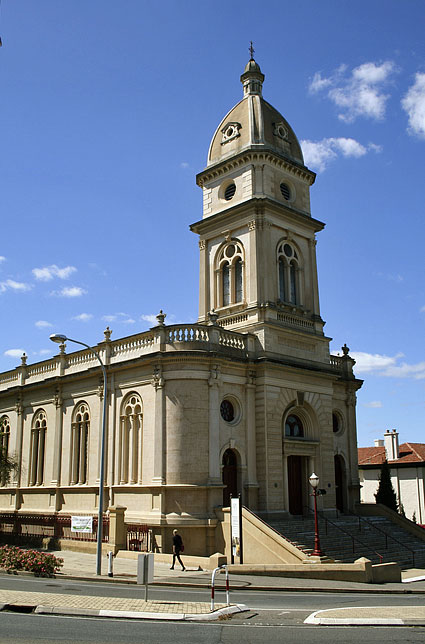
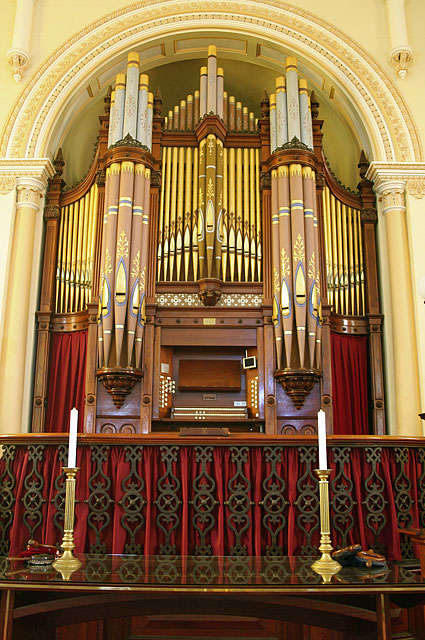
from OHTA CONFERENCE BOOK 1986
This former Congregational Church was left in a "rugged and unfinished state" for a period of twelve years before the tower and the interior and exterior finish were completed. [1] Special attention was paid to the acoustics and after the pipe organ was installed in 1882 the position of organist attracted many distinguished musicians, including T H Jones. [2] In March of 1881 the deacons of the church accepted the tender of Rendall to build their organ [3] and in July of that year the 16' Open Diapason pipes of "the largest two manual organ in the colony" were exhibited in the Adelaide Exhibition. [4] The organ was opened on March 28th 1882. [5] Three new stops were quickly added by June 1882. [6] The instrument has moved position and its action changed from tubular- to electro-pneumatic. Dodd restored the instrument in 1914. [7]
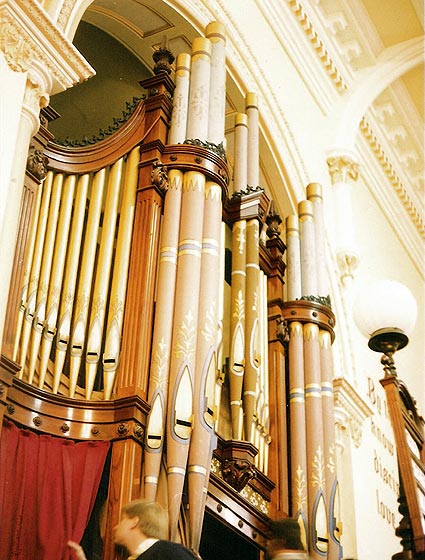
Photos: TB 1986
The specification is:
| Great Bourdon Open Diapason Claribel Keraulophon Salicional Principal Flute Twelfth Fifteenth Mixture Clarinet Swell Lieblich Bourdon Open Diapason Gedackt Gamba Harmonic Flute Fifteenth Mixture Horn Oboe Pedal Open Diapason Bourdon Bass Flute |
16 8 8 8 8 4 4 2-2/3 2 III 8 16 8 8 8 4 2 III 8 8 16 16 8 |
wood |
compass 56/30
3 Swell pistons
3 Great pistons
(all pistons inoperable)
Balanced Swell Pedal
Swell to Great
Great to Pedal
Swell to Pedal
Swell Suboctave
Swell Octave
Located in east wall.
From the 2009 OHTA Conference Book, David Shield writes:
Brougham Place Uniting Church is one of the most prominent
townscape features of Adelaide.
The organ is notable for its case and tonal design. Its location and action have changed
over time. The console has been
moved from its attached position and relocated to possibly two positions at
floor level before returning to its current location. The action has changed from tracker to pneumatic to
electric. The main bellows remains
in position but is disconnected and smaller bellows have taken its place. Motive power has changed for hand
pumping to hydraulic then electric motor.
There have been some minor changes in the stop list and labelling. Despite this, the instrument must be
regarded as one of Walter Rendall’s most important works.
On 15 May 1860, the foundation stone (taken from the bed of the
River Torrens) was laid. It is
interesting to note that in addition to the usual records of the day, copies of
the daily papers and coins of different denomination, was added a piece of
Australian gold and a piece of smelted copper from the Burra Burra Works.1 The church architects were Edmund
Wright and E.A. Hamilton and the traveller might be excused for making
comparisons with the many churches rebuilt by Christopher Wren after the Great
Fire of London in 1666 which “all had clear glass windows so as to show off the
wood carving, painted altar pieces and ironwork” of the church interior.2 Although Brougham Place had no painted
altar piece, and many of the original clear glass windows have now been
replaced with colour, it did have ironwork in the altar rail, since removed,
and plenty of soft hued timber.
The church was to remain in an unfinished state for a period of 12
years before the tower and interior and exterior finishes were complete. In 1871, Hamilton submitted a design
for a tower to be constructed to 107 feet (32.6m) in height. In 1878, Thomas Frost was commissioned
to plan a lecture hall, classrooms and organ gallery.3 The harmonium could be dispensed with,
allowing an organ to replace it.
In March 1881, the deacons of the church accepted the tender of a
young Walter Rendall to build their organ.4 Rendall had little experience and no
formal apprenticeship in building organs.5 By early the following year, Arthur Hobday, professionally
trained, clearly had the impression that Rendall was struggling to complete the
erection of the organ. In a letter
to Fincham in Melbourne he noted “Rendall has been three weeks now putting up
in the Church the new organ he has built for them and from all accounts will be
many more before complete”. This
may have been professional jealousy as Fincham & Hobday were trying to
establish themselves in Adelaide.
They were only just completing their first instrument for Norwood
Baptist Church, giving a factory recital on 1 April 1882.6 The competition was obviously
keen. In May “after a very severe
struggle” Hobday secured the order for the Presbyterian Church in Flinders
Street. The standard of Rendall’s
carved cedar case at Brougham Place is outstanding, with its display pipes
decorated in four styles; it consists of three towers and four flats with the
following arrangement of pipes: 9 5 6 3 6 5 9. The outer flats are curved, possibly deriving from the Hill
& Son organ at the Town Hall and there are ceramic tiles inlaid beneath the
impost. This apparently forced
Hobday to follow Rendall’s lead and give the Presbyterians a good case: “they made me give a second design
(with pipes in the ends as well as front) the first not being good enough.”7
The Rendall organ was opened on Sunday 26 March 1882 with
two special services. The organ
was regarded as a fine addition to the church presenting a handsome
appearance. The rich full volume of
sound and likewise the softer notes were satisfactory. The tone and power were as “superior to
any other in the city”. In June
the following year, the organ was “rendered more powerful and effective”. Presumably prepared for, Rendall added
a Double Diapason 16ft, 3-rank Mixture, and Violoncello 8ft.8 By 1891, the organ became
inoperable. Fincham & Hobday
repaired the organ and it was successfully reopened in May.9
The position of the organ made it
difficult for a combined organist/choirmaster to operate effectively. Early in 1910, Frederick Bevan sought
Dodd’s advice. In reply he
received the opinion “that the only satisfactory method to be adopted, to bring
the Choir and Organ under the entire control of the Director, is to Extend the
Console to a position in the present FRONT AISLE of the Church, and immediately
opposite the position at present occupied by the Key-board.”10 This was quite a radical move involving
new console and keyboard, stopkeys replacing drawstops and pneumatic action
throughout. The hydraulic engine
was to be kept, and remained till 1922 when replaced with an electric motor and
fan.11 A detailed
contract was drawn up but not acted upon until 1913-14. The “barrier rail” was also required to
be moved back.12 With minor changes, this appears to have been the
situation when Stiller documented the organ in 1980, remaining until the
rebuild in 2007. Stiller noted the
original Great Clarinet had been removed, and several ranks had been renamed. The Pedal Violoncello 8ft was now Bass
Flute 8ft, Swell Gemshorn 2ft renamed Fifteenth 2ft, Viola da Gamba 8ft
shortened to Gamba 8ft and Stopped Diapason 8ft renamed Gedackt 8ft. On the Great, the Clear Flute 4ft was
shortened to Flute 4ft. It is
noted that the Stopped Diapason 8ft has reappeared on the Great, presumably on
the slide originally occupied by the Clarionet.13
Of
interest is the small room to the right hand side of the organ where there is
the slot for the blowing handle.
An “Honorary Organ Blowers Association” membership listing is recorded
together with other historical graffiti.
The name of F. Bevan is prominent.
The hydraulic blowing engine remained in situ until major building
improvements were made c.1977. It
was photographed before removal and now with the vertical pumping beam is in the
possession of the South Australian Committee of OHTA.
Keri Williams was a foundation member of the Adelaide Harmony
Choir in 1947 and also a member of the church at Brougham Place. Largely
through his efforts the church was restored, receiving heritage listing. After his death in 1988, a memorial
concert was held with the proceeds to go towards the restoration of the organ,
a project that he also championed.14 Quotations were received from an organbuilder and advice
sought from OHTA Director Ray Holland during 1999, but action was not taken
until 2007 when the rebuilt drawknob console returned to its current position.
W.G. Rendall 1881, enl 1882;
repaired Fincham & Hobday 1891;
rebuilt J.E. Dodd 1914; rebuilt L.
Jacob 2007
2 manuals, 22 speaking stops,
electro-pneumatic action
|
GREAT
ORGAN |
|
|
|
Bourdon |
16 |
|
|
Open
Diapason |
8 |
|
|
Claribel |
8 |
|
|
Keraulophon |
8 |
|
|
Stopped
Diapason |
8 |
TC |
|
Salicional |
8 |
|
|
Principal |
4 |
|
|
Flute |
4 |
|
|
Twelfth |
2-2/3 |
|
|
Fifteenth |
2 |
|
|
Mixture |
III |
|
|
Swell to
Great |
|
|
|
|
|
|
|
SWELL
ORGAN |
|
|
|
Lieblich
Bourdon |
16 |
|
|
Open
Diapason |
8 |
|
|
Gedeckt |
8 |
|
|
Gamba |
8 |
|
|
Harmonic
Flute |
4 |
|
|
Fifteenth |
2 |
|
|
Mixture |
III |
|
|
Horn |
8 |
|
|
Oboe |
8 |
|
|
Tremulant |
|
|
|
Swell Sub |
|
|
|
Swell Octave |
|
|
|
|
|
|
|
PEDAL
ORGAN |
|
|
|
Open
Diapason |
16 |
|
|
Bourdon |
16 |
|
|
Bass Flute |
8 |
|
|
Great to
Pedal |
|
|
|
Swell to
Pedal |
|
|
Compass: 56/30
3 thumb
pistons to Great
3 thumb
pistons to Swell
2 toe pistons
to Pedal
Reversible toe
piston for Great to Pedal
Balanced swell
pedal
_________________________________________________________________________
1 Advertiser, 17 May 1860, p.3
2 Betjeman,
J., City of London Churches (Pitkin Guide, 1993), p.3
3 Marsden, S., et al,
Heritage of the City of Adelaide (1990), pp.331-32
4 Register, 5 March 1881, p. 5.2
5 See
sections on St Cyprian’s Church, North Adelaide and St Peter’s Church, Point
Pass for further examples of Rendall’s early work
6 Fincham
letters 12/41 (24 January 1882); ibid 12/46 5 (April 1882). For a wider discussion of those
involved in the factory recital, see: Shield D., ‘The Elusive Faith Blown :
Organists of South Australia’, OHTA News, vol.22, no.2 (April 1998), pp.16-18, 23-29; ibid,
vol.22, no.3 (July 1998), pp.22-27
7 Fincham
letters 12/50 25 (May 1882): Hobday to Fincham.
8 Advertiser, 1 April 1882, p. 2.2; Register, 19 June 1882, p.5.1
9 Fincham letters
7/391 (10 June 1891): Fincham to Dodd; ibid, 7/421 (30 June 1891): Fincham to
Dodd
10 DLB
1910-12: Dodd to Bevan
(21 January 1910): resent - DLB 1909-14: Dodd to Deacons 21 April 1913
11
Ibid.; DLB 1922-25: Dodd to J..O. McEwin 28 October 1922
12 The ‘Front
Aisle position’ of 1914 may have been a second move of console location. The water engine operating handle is
still located on the panelling immediately below the pulpit suggesting this was
a previous position of the console.
The new console was initially requested in 1910 to be walnut, but Dodd
maintained cedar was in keeping with the furnishings already in place: DLB
1909-14 (21 April
1913): Dodd to Deacons
13 Stiller
J., Documentation Uniting Church Brougham Place North Adelaide Organ (7 January 1980)
14 Programme with
Adelaide Harmony Choir: Keri Williams Memorial Concert 6/8/1989.
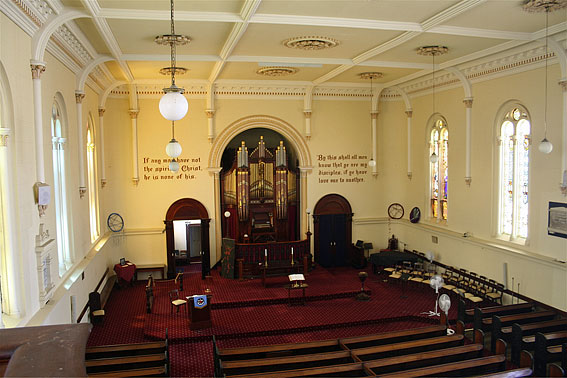
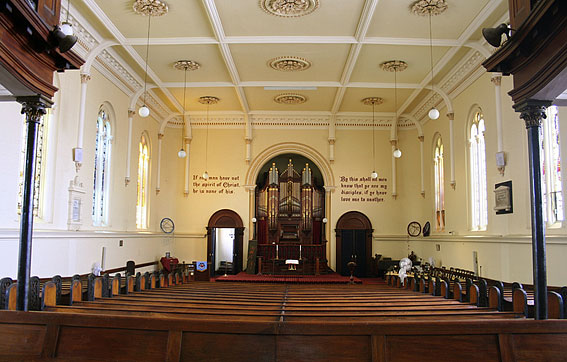
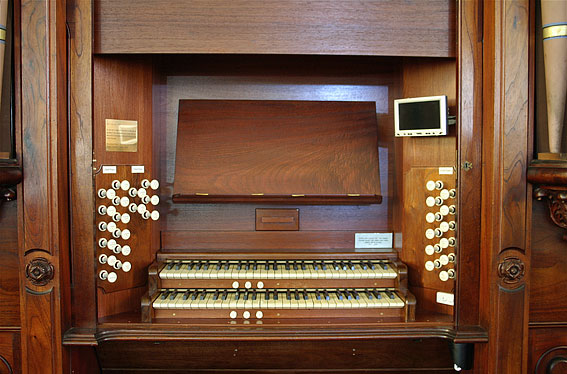
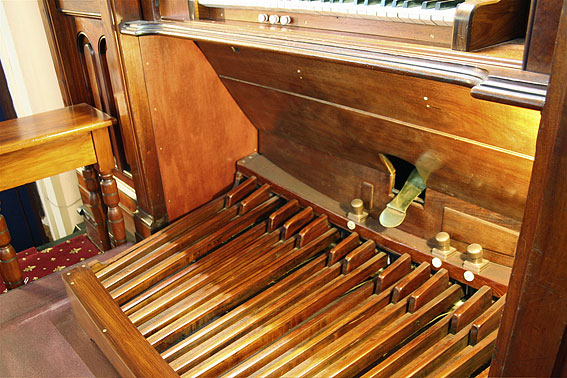
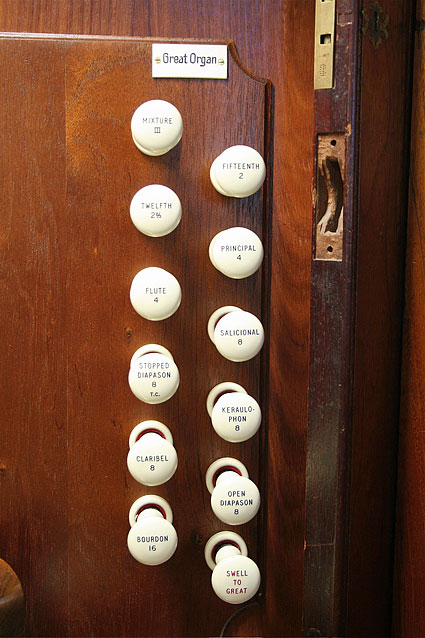

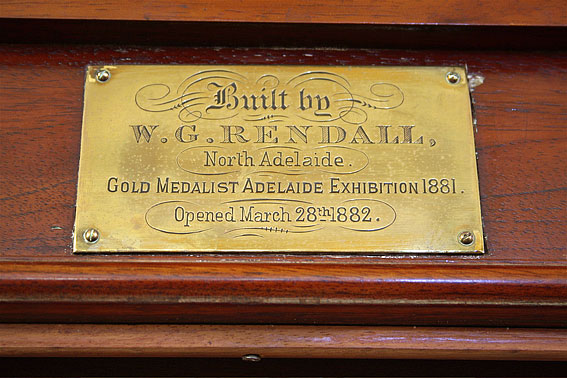
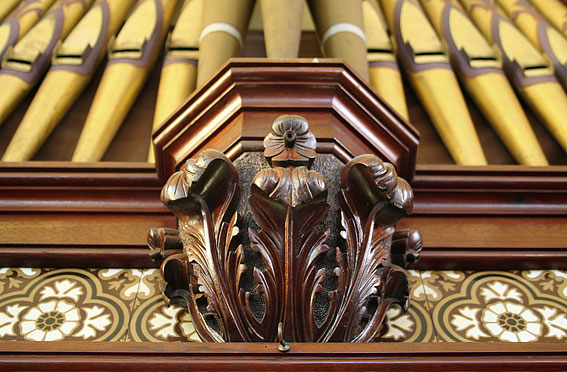
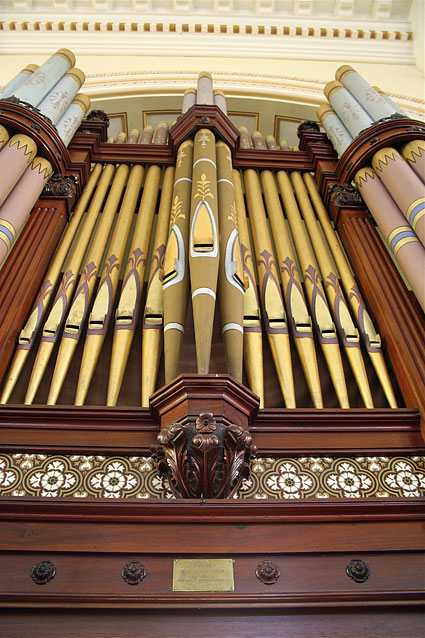
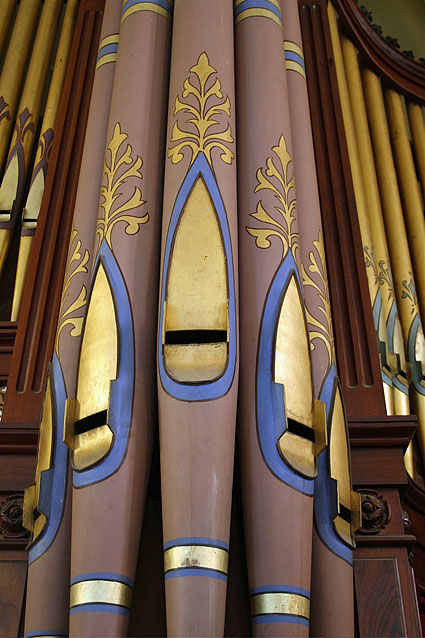
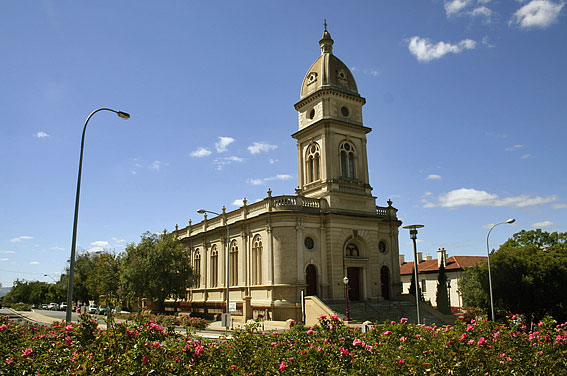
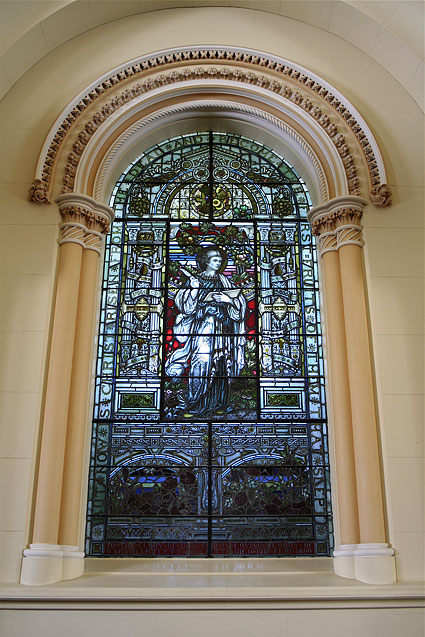
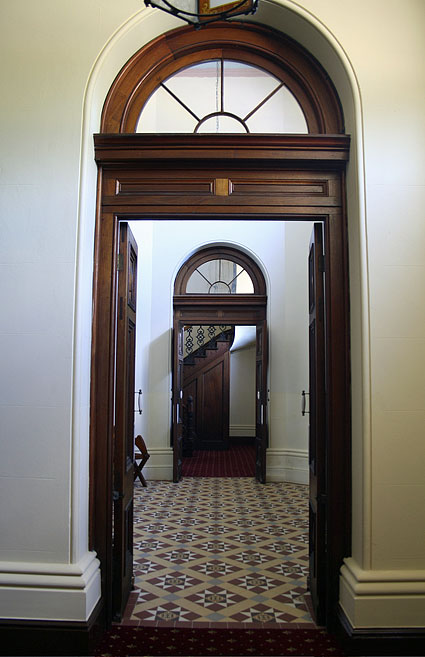
Trevor Bunning (March 2009)
[1] The Adelaide Observer Saturday July 20, 1872
[2] Pope op cit p7
[3] Register Saturday March 5 1881 p5, col 2
[4] ibid Exhibition Supplement Friday July 22, 1881 p2 col 6
[5] Naylor op cit pp 679-680
[6] Register Monday June 19 1882 p5 col 1
[7] Naylor op cit